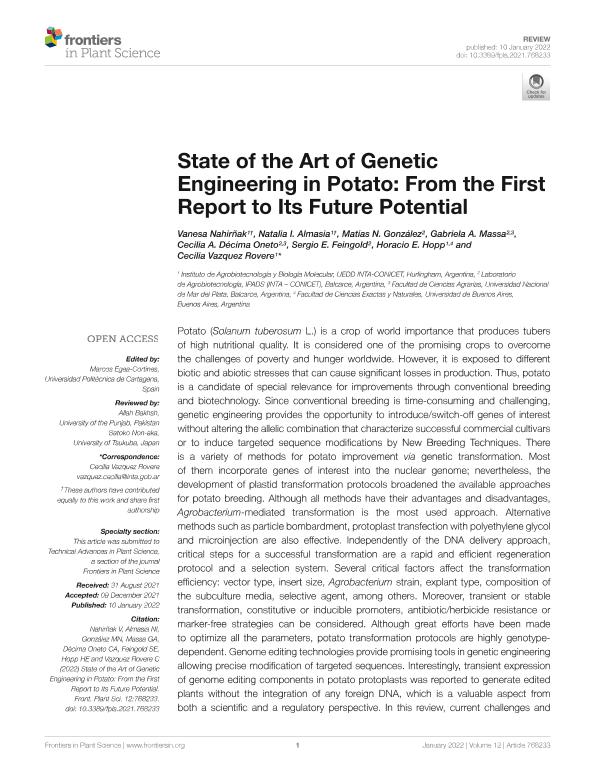Artículo
State of the Art of Genetic Engineering in Potato: From the First Report to Its Future Potential
Nahirñak, Vanesa ; Almasia, Natalia Ines
; Almasia, Natalia Ines ; Gonzalez, Matias Nicolas; Massa, Gabriela Alejandra
; Gonzalez, Matias Nicolas; Massa, Gabriela Alejandra ; Décima Oneto, Cecilia Andrea; Feingold, Sergio; Hopp, Horacio Esteban; Vazquez Rovere, Cecilia
; Décima Oneto, Cecilia Andrea; Feingold, Sergio; Hopp, Horacio Esteban; Vazquez Rovere, Cecilia
 ; Almasia, Natalia Ines
; Almasia, Natalia Ines ; Gonzalez, Matias Nicolas; Massa, Gabriela Alejandra
; Gonzalez, Matias Nicolas; Massa, Gabriela Alejandra ; Décima Oneto, Cecilia Andrea; Feingold, Sergio; Hopp, Horacio Esteban; Vazquez Rovere, Cecilia
; Décima Oneto, Cecilia Andrea; Feingold, Sergio; Hopp, Horacio Esteban; Vazquez Rovere, Cecilia
Fecha de publicación:
01/2022
Editorial:
Frontiers Media S.A.
Revista:
Frontiers in Plant Science
e-ISSN:
1664-462X
Idioma:
Inglés
Tipo de recurso:
Artículo publicado
Clasificación temática:
Resumen
Potato (Solanum tuberosum L.) is a crop of world importance that produces tubers of high nutritional quality. It is considered one of the promising crops to overcome the challenges of poverty and hunger worldwide. However, it is exposed to different biotic and abiotic stresses that can cause significant losses in production. Thus, potato is a candidate of special relevance for improvements through conventional breeding and biotechnology. Since conventional breeding is time-consuming and challenging, genetic engineering provides the opportunity to introduce/switch-off genes of interest without altering the allelic combination that characterize successful commercial cultivars or to induce targeted sequence modifications by New Breeding Techniques. There is a variety of methods for potato improvement via genetic transformation. Most of them incorporate genes of interest into the nuclear genome; nevertheless, the development of plastid transformation protocols broadened the available approaches for potato breeding. Although all methods have their advantages and disadvantages, Agrobacterium-mediated transformation is the most used approach. Alternative methods such as particle bombardment, protoplast transfection with polyethylene glycol and microinjection are also effective. Independently of the DNA delivery approach, critical steps for a successful transformation are a rapid and efficient regeneration protocol and a selection system. Several critical factors affect the transformation efficiency: vector type, insert size, Agrobacterium strain, explant type, composition of the subculture media, selective agent, among others. Moreover, transient or stable transformation, constitutive or inducible promoters, antibiotic/herbicide resistance or marker-free strategies can be considered. Although great efforts have been made to optimize all the parameters, potato transformation protocols are highly genotype-dependent. Genome editing technologies provide promising tools in genetic engineering allowing precise modification of targeted sequences. Interestingly, transient expression of genome editing components in potato protoplasts was reported to generate edited plants without the integration of any foreign DNA, which is a valuable aspect from both a scientific and a regulatory perspective. In this review, current challenges and opportunities concerning potato genetic engineering strategies developed to date are discussed. We describe their critical parameters and constrains, and the potential application of the available tools for functional analyses or biotechnological purposes. Public concerns and safety issues are also addressed.
Archivos asociados
Licencia
Identificadores
Colecciones
Articulos (IPADS BALCARCE)
Articulos de INSTITUTO DE INNOVACIÓN PARA LA PRODUCCIÓN AGROPECUARIA Y EL DESARROLLO SOSTENIBLE
Articulos de INSTITUTO DE INNOVACIÓN PARA LA PRODUCCIÓN AGROPECUARIA Y EL DESARROLLO SOSTENIBLE
Citación
Nahirñak, Vanesa; Almasia, Natalia Ines; Gonzalez, Matias Nicolas; Massa, Gabriela Alejandra; Décima Oneto, Cecilia Andrea; et al.; State of the Art of Genetic Engineering in Potato: From the First Report to Its Future Potential; Frontiers Media S.A.; Frontiers in Plant Science; 12; 768233; 1-2022; 1-19
Compartir
Altmétricas



